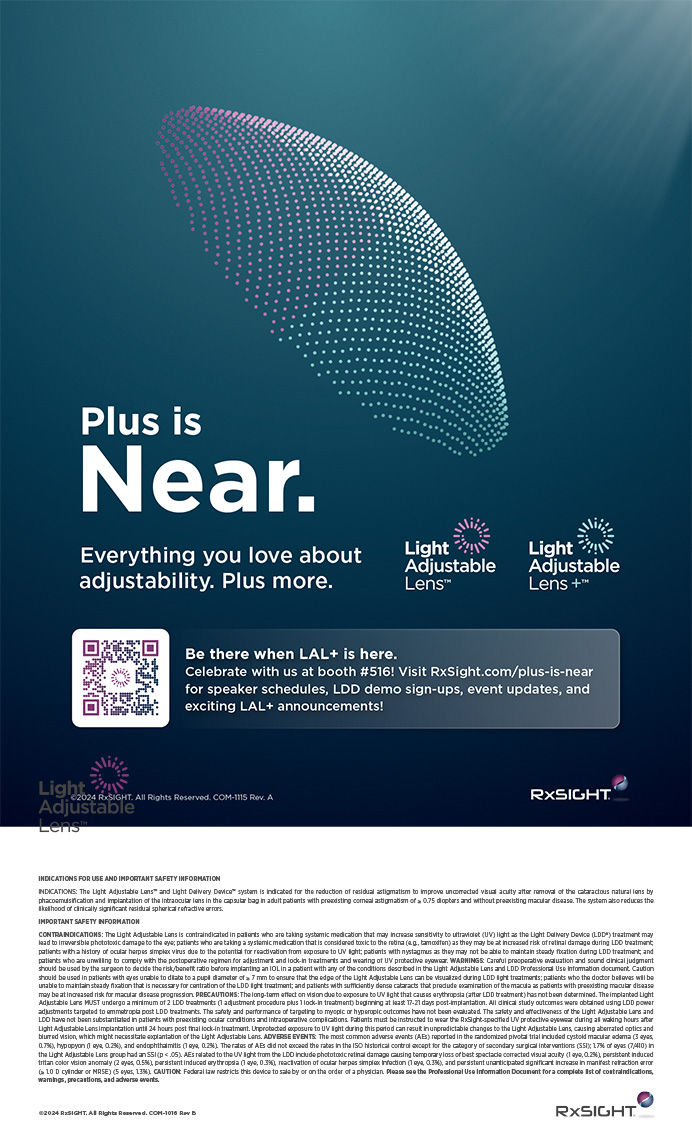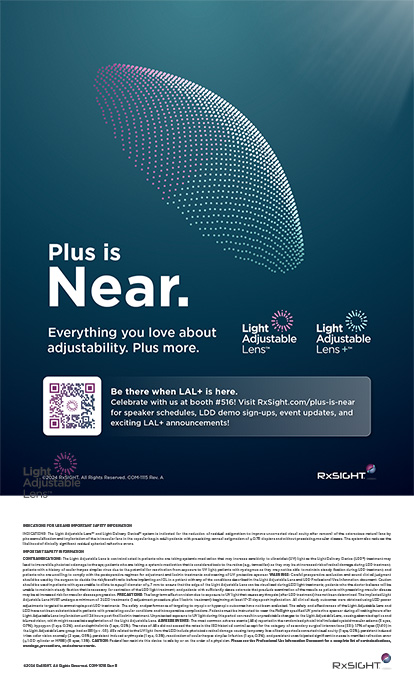From personal cameras and video recorders to mainstream television, imaging in every aspect of our lives has moved to a digital platform. In the ophthalmic OR, procedures are commonly viewed and recorded in two dimensions through secondary viewing systems in microscopy or a primary viewing system in procedures like endoscopic cyclophotocoagulation. In what some have called a paradigm shift, digital imaging now enables surgeons to perform microsurgical procedures with heads-up, high-definition (HD), three-dimensional (3-D) displays rather than through traditional microscope oculars.
Since its incorporation into my OR almost 3 years ago, the impact of TrueVision (TrueVision Systems, Inc., Santa Barbara, CA) on visitors and staff has been profound. I have used this real-time, 3-D HD system for both primary and secondary visualization in anterior segment surgery, including cataract, refractive, glaucoma, corneal, and strabismus procedures.
Three-dimensional technical advances are helping surgeons to capture and display surgery in real time and play it back to audiences for educational purposes.
PRIMARY COMPONENTS
TrueVision has three primary components (Figure 1). The first is a 3-D video camera that attaches to the microscope in line with or in place of the microscope oculars. The camera contains two HD sensors that emulate the binocular system’s depth of field. Second, a workstation processes the images through a dual projection system. The third main component is a widescreen display panel.
The camera streams nearly 2 GB of data per second, and the computer interprets the information to display 3-D HD video in real time. As for a 3-D movie, customized spectacles combine right and left stereo images that enable visitors, students, and staff to see precisely what the surgeon sees. With the addition of innovative cataract toolset software applications, newer generations of this system surpass the capabilities of the current microscope to allow for more precise, standardized refractive outcomes.1
OPHTHALMIC EDUCATION IN 3-D
Stereo video from TrueVision debuted at the AAO Annual Meeting in 2008 as part of an educational course where attendees donned stereo glasses to view horizontal and vertical phaco chop techniques in 3-D HD.2 Since then, the technology’s adoption has grown quickly so that presentations in 3-D HD have become a standard part of the curriculum at professional meetings (Figure 2). When teaching a chopping technique, I have found that many of the motions are in the vertical plane, and the biggest challenge is learning how deep to position the chopper and phaco tip. Learning to appreciate the correct depth for optimal holding with the phaco needle and separating with the chopper can be difficult. In my experience, the 3-D platform and its increased depth of field permit students to see precisely how deep the instruments are placed.
Similarly, one of the challenges of adopting biaxial phacoemulsification, with the separation of infusion and aspiration, is learning the most effective placement of the phaco tip and irrigating chopper relative to each other in the vertical plane. If the stream of irrigating fluid washes material away from the phaco tip, it prolongs the procedure and may set the stage for surgical re-intervention if the surgeon leaves a piece of nucleus in the angle or the sulcus. In addition, keeping the stream high up in the chamber in cases of intraoperative floppy iris syndrome prevents the iris from billowing and prolapsing. The 3-D HD imagery facilitates understanding of the critical vertical dimension for these techniques.
The educational applications of 3-D microsurgery are not limited to showing videos at professional meetings. Threedimensional images can be played back or viewed directly during surgery as education for patients and their families. In my experience, this type of visual display seems to demystify the surgery by showing patients what I am doing in the eye. They experience a “wow” factor and gain insight that they would not with a two-dimensional system. Their reactions and feedback have been consistently positive, and their anxiety has decreased. In fact, one woman who was watching her husband’s cataract surgery commented that she would not wait any longer to have hers done.
The images projected on the visual display are also a wonderful teaching tool for the OR staff. In the standard OR setup, the surgeon is the only person who has a full stereoscopic view. A 3-D display system creates a different visual experience, because it gives personnel an opportunity to see exactly what the surgeon sees while operating. It has increased synergy in the OR, where my scrub nurses can understand when I have a problem and can anticipate the next instrument needed. I can use my peripheral vision to transfer instruments easily, safely, and efficiently. A more involved staff improves the workflow in the OR.
EVIDENCE SUPPORTS THE EFFICACY OF 3-D LEARNING
Recently, ESPN Research + Analytics performed one of the most in-depth studies on 3-D television to date. Compiling the results from more than 1,000 testing sessions and 2,700 laboratory hours, ESPN concluded that fans are comfortable with the medium and that they enjoy it more than programming in HD. The research was conducted by Duane Varan, professor of new media at Murdoch University and executive director of the Interactive Television Research Institute, at the Disney Media and Ad Lab in Austin, Texas, during ESPN’s coverage of the 2010 FIFA World Cup.3 The bullet points of interest are
• Recall increased from 68% in two dimensions to 83% in 3-D
• Advertising purchase intent went from 49% to 83%
• Sense of presence went from 42% to 69%
• There were no adverse effects on depth perception
Meanwhile, Texas Instruments has generated enthusiasm for the effectiveness of 3-D education in the classroom. In the company’s joint initiative with the Rock Island-Milan School District in Illinois, teachers developed and delivered a simulation of and lesson on computing the volume of complex shapes for more than 1,000 students in grades 3 through 6 across all demographics, including students with individual educational plans (or special education). The overall average gain in test scores between a prelesson and a postlesson test was 32%, compared with a 9.7% gain in a pilot study control group. “This was a dramatic difference— for both our teachers and students,” said Rick Loy, superintendant of schools for the Rock Island School District. “The improvements were significant and frankly, amazing, compared to traditional textbook methods.”4
THE FUTURE OF VIDEO EDUCATION
Anyone familiar with the mathematical literary classic Flatland by Edwin Abbot understands the limitations inherent in dimensionality.5 Comprehending 3-D surgical procedures on a two-dimensional screen is like watching shadow puppets on a wall and extrapolating their real nature. There is room for error, misinterpretation, and mistakes. Threedimensional imaging provides a way to see a true image of the object in space, which improves cognition and makes intuitive sense. Now, researchers have the opportunity to demonstrate improved educational outcomes by studying the effectiveness of 3-D surgical training in a formal way. I suggest making the most of it.
Mark Packer, MD, CPI, is a clinical associate professor at the Casey Eye Institute, Department of Ophthalmology, Oregon Health and Science University, and he is in private practice with Drs. Fine, Hoffman & Packer, LLC. He is a consultant to TrueVision Systems, Inc. Dr. Packer may be reached at (541) 687-2110; mpacker@finemd.com.
- TrueVision 3D system receives 510(k) clearance for image-guided ophthalmic surgery.EyeWire Today.http://www.eyewiretoday. com/index.asp?article=20110105-truevision_3d_system_receives_510k_clearance_for_imageguided_ ophthalmic_surgery.Accessed January 9,2011.
- Packer M.Skills Transfer Program:Microincision Cataract Surgery.Presented at:American Academy of Ophthalmology & European Society of Ophthalmology 2008 Joint Meeting;November 8-11,2008;Atlanta,GA.
- ESPN announces results of comprehensive 3D study.ESPN Media Zone.http://www.espnmediazone3.com/us/2010/11/3dstudy/. Posted November 10,2010.Accessed January 9,2011.
- Improved test scores with 3D.Texas Instruments.http://www.dlp.com/projector/case-studies/improved-test-scores-3d.aspx. Accessed January 8,2011.
- Abbot EA.Flatland:a Romance of Many Dimensions.http://www.geom.uiuc.edu/~banchoff/Flatland/.Published in 1884. Accessed January 8,2011.


